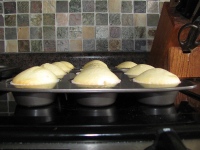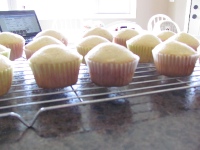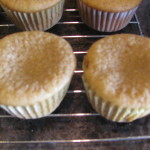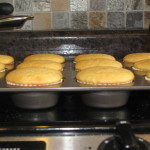G had a mystery. Her gluten free cupcakes kept sinking in the middle. They were beautiful when they came out of the oven. But, turn your back to get the icing from the refrigerator*, and they’d quickly do their best impression of a dormant volcano. She emailed me to see if I could help her figure out why these sneaky cupcakes kept foiling her attempts at a perfect gluten free dessert.
OK, here are some pics of my cupcakes..you can see that they look all nice in the oven but fall in the middle after I get them out. I did use a few tweaks in my recipe yesterday but it doesn’t matter…this is still pretty typical of how my cupcakes look. Can you help? ~G
What do you do when a recipe doesn’t work and you have no idea why?
The first thing that I want to do is take a look at the recipe as a whole. I had G send me the recipe – in grams. Recipes are mathematical. If you want to understand them, then you have to look at the relative weights of ingredients, and you can’t do that if the recipe is written in cups and teaspoons.
Once the recipe was in grams I completely geeked out! I threw the recipe into a spreadsheet and analyzed the relative quantities of various ingredients. I also compared it to a similar cake recipe of mine that I knew was a sound.
This analysis made two things very clear.
1. G’s recipe was overleavened….by 233%
2. Her recipe contained much less fat than my recipe
I emailed G and explained my findings:
I just did a ratio analysis of your cupcake recipe and two things stand out to me. First, your recipe is overleavened. Baking soda is 4x as strong as baking powder, so 9 grams of baking powder + 3 grams of baking soda = 21 grams baking powder. The 9 grams of baking powder should be sufficient by itself to raise the cupcakes.
Try that change by itself first and see how it goes.
The second thing that I noticed is that your cake seems rather short on fat. I’d be perfectly comfortable using up to 175 grams of fat, especially since you’re using whole eggs rather than egg yolks only. ~ Mary Frances
By the next morning I had a reply in my inbox.
OK, I took your suggestions…and LOOK! They look the same as they did when they came out of the oven! And the texture is nice and pillowy…soft, yet dense enough to not fall apart. Not gummy! Thanks SO much for your help…I think that did it!!! ~G


*I do realize that you wouldn’t spread icing on cupcakes right after they came out of the oven. That would be silly. But, that doesn’t mean that you can’t have a spoonful of icing while you contemplate the beauty of your still-hot cupcakes!


Those look fabulous–can you share the recipe?
I’ve been having that same problem. Recipe looks beautiful in the cookbook, but not after five minutes out of my oven. Thought it was my oven, me, cooking time, then finally just blamed it on being gluten, dairy, and egg free. I will try leaving out the baking soda next time and see if it helps. It is an allergy free recipe, so it was created without using eggs (I wasn’t subbing ingredients). I realize your recipe had eggs, but I hope the fix will work the same 🙂
Kari, I’ve just found that if you increase the temperature slightly (I did 20 degrees C 180 up to 200 Celcius) It helps keep the structure. Don’t have the mix too moist and don’t overfill the patty cases. I’ve also reduced the bicarbonate soda if all that fails.
I’ve been working on a cupcake recipe for months. I need to learn the science behind the recipe because when you use cup/spoon measures it allows the recipe to fluctuate too much. Weights are far better to work with when baking. I do gluten, dairy and egg free too.
Hello Mary Frances, thank you for what you do. I subscribed to your site quite awhile ago but typically cannot use your recipes due to not knowing how to substitute for the ingredients that you use. 🙁
I was not a “cook” before sensitivities were diagnosed and so do not necessarily understand the chemistry behind cooking in the first place. But I have been learning out of necessity. Unfortunately, we still cannot eat so many things b/c we react to most of the GF alternative flours, dairy, eggs, etc still (we know from real life experience). And unfortunately, those personal abnormal reactions are one of the main reasons why I can not rely on your pre-tested creations. So my question is how did you learn the mathematics of your cooking formula. I want to try new things and learn how to experiment but need a more sure way to experiment … so I don’t keep throwing away money on failed experiments.
Thank you for your insight and advice.
Dawn : )
This is a great story. Could you share the ratios that your spreadsheet came up with for your “good cake”?
I followed Mary’s recipe from her site and had no problem.
I purchased a scale and now weigh everything – per Mary’s suggestion – and cakes, cupcakes and especially that great sandwich bread – all come out perfect.
I’ve actually been having the exact same issue with completely different recipes. I have noticed overall that all of my gluten free cakes are way shorter than the original versions. I paid close attention and noticed that just out of the oven, the cakes were flawless, but I’d turn my back and kaput :(.
I’ve done devil’s food and a few different versions of yellow cake, including one with a foam base. I even did a pound cake with no leavening agent at all and the same story again. It was a half batch, so here’s what I used, 1-1/2 c of my gluten free mix, 1-1/4 c sugar, 4.5 eggs, 2 sticks butter, 1/2 tsp coarse sea salt, and a little extract. Any ideas? I baked at 325F, and it was lovely just out of the oven